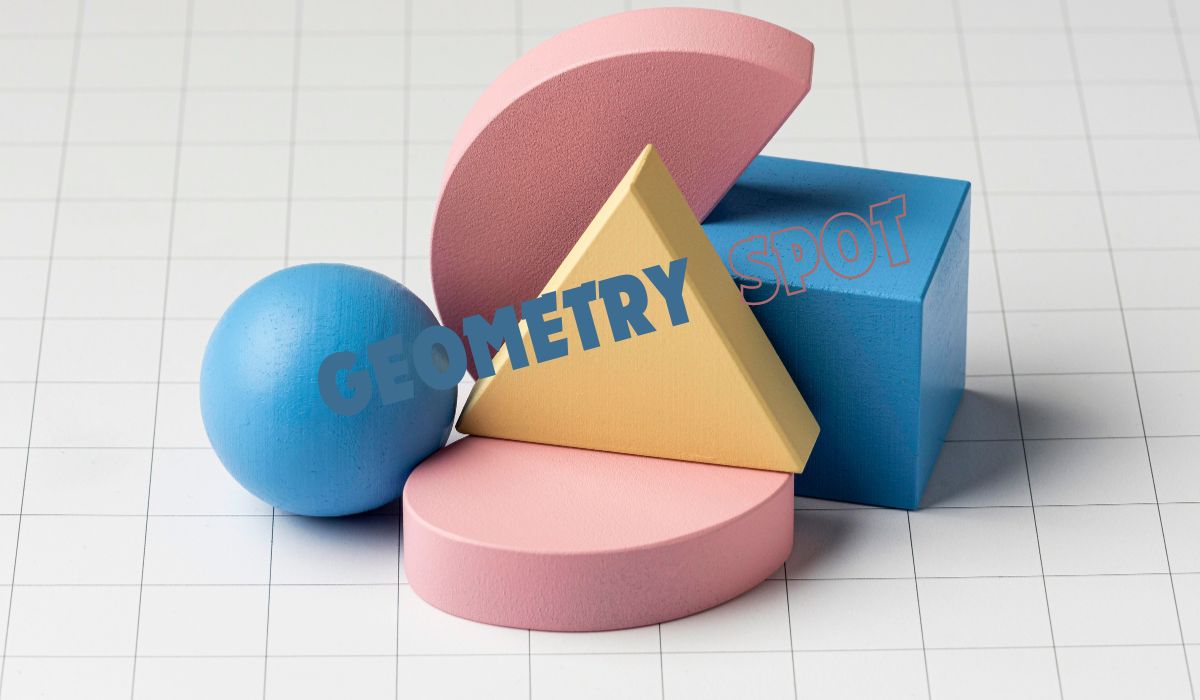EDUCATION
Geometry Spot: Master Geometry with Engaging Tools and Professional Approaches

Introduction
Geometry has long been considered one of the most challenging subjects for students. The intricate relationships between shapes, theorems, and formulas often create a steep learning curve. However, the advent of digital learning platforms has revolutionized education, making complex subjects like geometry more accessible and engaging. Among these platforms, Geometry Spot stands out as a comprehensive online resource that enables learners to master geometry through engaging tools, interactive activities, and professional approaches. This article explores the features, benefits, and strategies offered by Geometry Spot, showing how it transforms the learning experience.
The Challenges of Learning Geometry
Complexity of Concepts
Geometry involves a wide range of concepts that require a deep understanding of spatial relationships, logic, and abstract reasoning. Students often struggle with visualizing geometric figures, comprehending theorems, and applying formulas correctly. Traditional classroom settings may not provide enough time or resources for students to fully grasp these concepts, leading to frustration and a lack of confidence.
Memorization vs. Understanding
Another challenge in learning geometry is the tendency to focus on memorizing formulas and theorems rather than understanding the underlying principles. This approach often results in short-term retention and difficulties in applying knowledge to solve complex problems. Students may know the formulas but fail to recognize when and how to use them effectively.
Geometry Spot: A Game-Changer in Geometry Education
Geometry Spot addresses these challenges by offering a wide array of tools and resources designed to enhance understanding and engagement. The platform provides a structured learning environment that emphasizes both conceptual understanding and practical application. Let’s delve into the key features that make Geometry Spot a valuable resource for students and educators alike.
Interactive Learning Tools
Dynamic Geometry Software
One of the standout features of Geometry Spot is its dynamic geometry software, which allows students to interact with geometric figures in real time. Unlike static diagrams in textbooks, this software lets users manipulate shapes, explore properties, and observe relationships between different geometric elements. For example, students can drag the vertices of a triangle to see how changes in angles and sides affect the overall figure. This hands-on approach promotes a deeper understanding of geometric concepts.
Visualization and 3D Modeling
Geometry Spot also excels in providing tools for visualization and 3D modeling. Understanding three-dimensional shapes can be particularly challenging for students, but with the platform’s 3D modeling tools, learners can rotate, scale, and explore complex figures from various angles. This interactive experience makes it easier to grasp the properties of 3D shapes, such as volume and surface area, and understand how they relate to their two-dimensional counterparts.
Engaging Learning Activities
Gamified Learning
To keep students motivated and engaged, Geometry Spot incorporates gamified learning activities. These activities turn geometry problems into interactive games, where students earn points, badges, or other rewards for solving problems correctly. This element of competition and achievement encourages students to practice more and reinforces their learning in a fun and interactive way.
Interactive Quizzes and Assessments
Geometry Spot offers a variety of interactive quizzes and assessments that cater to different learning levels. These quizzes are designed to test students’ understanding of key concepts and provide immediate feedback. The platform’s adaptive learning technology adjusts the difficulty of questions based on the student’s performance, ensuring that they are always challenged at an appropriate level. This personalized approach helps identify areas of weakness and allows students to focus on improving specific skills.
Professional Approaches to Learning
Guided Tutorials and Video Lessons
Geometry Spot provides guided tutorials and video lessons created by experienced educators. These resources are designed to break down complex concepts into manageable steps, making it easier for students to follow along. The video lessons often include real-world examples, helping students see the practical applications of geometry in fields such as architecture, engineering, and art. This connection to real-life scenarios enhances students’ interest and understanding of the subject.
Step-by-Step Problem Solving
One of the most effective ways to learn geometry is through step-by-step problem solving, and Geometry Spot excels in this area. The platform offers detailed explanations and step-by-step solutions to a wide range of geometry problems. Students can follow along with the solutions, understanding each step before moving on to the next. This method not only reinforces learning but also helps students develop critical thinking and problem-solving skills.
Advantages of Using Geometry Spot
Personalized Learning Experience
Geometry Spot’s adaptive learning technology ensures that each student receives a personalized learning experience. The platform tracks progress, identifies strengths and weaknesses, and adjusts the content accordingly. This personalized approach ensures that students are always working at their optimal level, maximizing their learning potential.
Flexibility and Convenience
One of the significant advantages of Geometry Spot is the flexibility it offers. Students can access the platform anytime and anywhere, making it easy to fit learning into their schedules. Whether they are studying at home, in a library, or on the go, Geometry Spot provides a convenient way to learn and practice geometry.
Support for Teachers and Educators
Geometry Spot is not just for students; it also offers valuable resources for teachers and educators. The platform provides lesson plans, teaching guides, and assessment tools that help educators plan their curriculum and monitor student progress. Teachers can use Geometry Spot to supplement their classroom instruction, assign homework, and track student performance over time.
Case Studies: Success Stories from Geometry Spot Users
To illustrate the impact of Geometry Spot, let’s look at some real-life success stories from students and educators who have benefited from the platform.
Student Success Story: Overcoming Geometry Anxiety
One high school student, Emily, struggled with geometry and often felt anxious about tests and quizzes. Her teacher recommended Geometry Spot as a supplemental resource. Emily began using the platform regularly, starting with the interactive tutorials and quizzes. Over time, she gained confidence in her ability to solve geometry problems and saw a significant improvement in her grades. By the end of the school year, Emily had not only overcome her geometry anxiety but also developed a genuine interest in the subject.
Educator Success Story: Enhancing Classroom Instruction
Ms. Johnson, a middle school math teacher, integrated Geometry Spot into her curriculum to enhance her students’ learning experience. She used the platform’s dynamic geometry software to create interactive lessons that allowed students to explore geometric concepts in a hands-on way. Ms. Johnson also assigned Geometry Spot’s quizzes as homework, using the platform’s assessment tools to monitor her students’ progress. As a result, her students showed a marked improvement in their understanding of geometry, and classroom engagement levels increased significantly.
Optimizing Learning with Geometry Spot: Tips and Strategies
Setting Learning Goals
To maximize the benefits of Geometry Spot, it’s essential for students to set clear learning goals. Whether it’s mastering a particular concept or improving overall performance, having specific goals helps students stay focused and motivated. Geometry Spot’s personalized learning paths can be aligned with these goals, providing a roadmap for success.
Regular Practice and Review
Consistency is key when it comes to learning geometry. Regular practice and review of concepts help reinforce understanding and prevent knowledge gaps. Geometry Spot’s interactive activities and quizzes make it easy for students to practice regularly and review concepts as needed.
Utilizing Support Resources
Geometry Spot offers a wealth of support resources, including guided tutorials, video lessons, and step-by-step problem solving. Students should take full advantage of these resources, especially when encountering challenging concepts. Teachers can also utilize these resources to provide additional support and guidance to their students.
Geometry Spot vs. Traditional Learning Methods
Engagement and Interactivity
One of the primary differences between Geometry Spot and traditional learning methods is the level of engagement and interactivity. Traditional methods often rely on textbooks and static diagrams, which can be less engaging for students. In contrast, Geometry Spot’s interactive tools and gamified activities make learning more dynamic and enjoyable, leading to better retention and understanding.
Personalized Learning Paths
Traditional classroom settings often follow a one-size-fits-all approach, which may not cater to the individual needs of each student. Geometry Spot’s personalized learning paths, on the other hand, ensure that students receive instruction tailored to their specific strengths and weaknesses. This personalized approach is more effective in helping students achieve their learning goals.
Accessibility and Flexibility
Traditional learning methods are typically confined to the classroom and limited by time constraints. Geometry Spot offers unparalleled accessibility and flexibility, allowing students to learn at their own pace and on their schedule. This flexibility is particularly beneficial for students who may need extra time to master certain concepts or those who wish to accelerate their learning.
The Future of Geometry Education with Geometry Spot
As technology continues to advance, platforms like Geometry Spot are likely to play an increasingly important role in education. The integration of artificial intelligence, virtual reality, and augmented reality could further enhance the learning experience, making geometry even more accessible and engaging. Geometry Spot’s commitment to innovation and professional approaches ensures that it will remain a leader in geometry education for years to come.
Conclusion
Geometry Spot is a game-changer in the world of geometry education, offering a comprehensive and engaging learning experience for students and educators alike. With its interactive tools, personalized learning paths, and professional resources, Geometry Spot makes mastering geometry not only achievable but also enjoyable. Whether you’re a student struggling with geometry or a teacher looking for innovative ways to enhance your instruction, Geometry Spot has the tools and resources to help you succeed. By embracing the platform’s features and strategies, learners can overcome the challenges of geometry and develop a strong foundation in this essential mathematical discipline.

EDUCATION
Cruciais: The Power of Crucial Questioning in a World of Information Overload

In today’s rapidly evolving world, where information is abundant and easily accessible, the ability to question, analyze, and make informed decisions has never been more critical. This concept is encapsulated in the term “Cruciais,” which signifies not only the importance of pivotal decisions but also the adaptability and innovation required to navigate the complexities of modern life. From its historical origins to its contemporary applications, Cruciais represents the power of critical thinking and its profound impact on various aspects of our lives.
Understanding Cruciais: Origins and Meaning
The term “Cruciais” derives from the Latin word “crux,” meaning “cross” or “significant point.” Historically, it has been associated with decisions or moments that carry significant weight—those turning points that can alter the course of events. In today’s context, Cruciais extends beyond mere decision-making; it embodies the essence of critical questioning, analytical thinking, and the ability to adapt to new information and changing circumstances.
Check: Opeño Unveiling the Mysteries
Historical Context of Crucial Decision-Making
Throughout history, crucial decisions have shaped the course of civilizations. Consider the decision of Julius Caesar to cross the Rubicon River in 49 B.C., which led to the Roman Civil War and ultimately transformed the Roman Republic into the Roman Empire. This decision, encapsulated in the phrase “the die is cast,” highlights the profound impact that a single choice can have on the trajectory of history.
Similarly, during World War II, the decision by the Allied forces to launch the D-Day invasion on June 6, 1944, was a pivotal moment that changed the tide of the war. The success of this operation required meticulous planning, strategic thinking, and the ability to adapt to unforeseen challenges—qualities that are at the heart of Cruciais.
The Role of Cruciais in Modern Society
In the current era of information overload, where data is readily available and often overwhelming, the need for Cruciais has become more pronounced. The ability to sift through vast amounts of information, discern what is important, and make informed decisions is crucial for individuals, businesses, and governments alike.
The Importance of Critical Thinking
At the core of Cruciais is the concept of critical thinking—the ability to analyze information objectively, evaluate different perspectives, and make reasoned judgments. In a world where misinformation and fake news are prevalent, critical thinking skills are essential for navigating the digital landscape and making informed decisions.
Example: In the field of healthcare, critical thinking is vital for making decisions that affect patient outcomes. Medical professionals must be able to evaluate complex data, consider different treatment options, and weigh the risks and benefits to provide the best care possible. The COVID-19 pandemic, for instance, highlighted the importance of critical thinking in making decisions about public health measures, vaccine development, and resource allocation.
Adaptability and Innovation
Cruciais also emphasizes the importance of adaptability and innovation in today’s dynamic world. As the pace of change accelerates, individuals and organizations must be able to adapt to new technologies, market trends, and societal shifts. This requires not only the ability to question the status quo but also the willingness to embrace new ideas and approaches.
Example: The rise of remote work during the COVID-19 pandemic is a prime example of the need for adaptability. Companies that were able to quickly pivot to remote operations and leverage digital tools for communication and collaboration were better positioned to navigate the challenges of the pandemic. This adaptability is a key component of Cruciais, as it allows for the continuous evolution and improvement of processes and strategies.
Cruciais in Business: The Key to Strategic Success
In the business world, Cruciais plays a critical role in strategic decision-making. Companies that excel in crucial questioning and critical thinking are better equipped to navigate uncertainty, identify opportunities, and achieve long-term success.
Strategic Decision-Making
Strategic decision-making involves making choices that have long-term implications for an organization’s direction and success. This requires a deep understanding of the internal and external factors that influence the business environment, as well as the ability to anticipate and respond to changes.
Example: Apple Inc.’s decision to transition from Intel processors to its own custom-designed M1 chips is an example of strategic decision-making driven by Cruciais. This move, announced in 2020, was the result of careful analysis of market trends, technological advancements, and the need for greater control over the hardware-software integration in its products. The decision has allowed Apple to enhance performance, reduce costs, and differentiate itself from competitors, demonstrating the power of crucial questioning in driving innovation.
Risk Management and Mitigation
Cruciais is also essential in risk management and mitigation. Businesses face a multitude of risks, from financial uncertainties to operational challenges and reputational threats. Effective risk management requires the ability to identify potential risks, assess their impact, and develop strategies to mitigate them.
Example: The 2008 financial crisis serves as a stark reminder of the consequences of inadequate risk management. Financial institutions that failed to critically assess the risks associated with subprime mortgages and complex financial instruments faced catastrophic losses. In contrast, organizations that applied Cruciais by rigorously questioning assumptions, stress-testing models, and diversifying their portfolios were better able to weather the storm.
Cruciais in Personal Development: Empowering Individuals
Beyond its applications in business and society, Cruciais is also a powerful tool for personal development. By cultivating critical thinking, adaptability, and strategic decision-making skills, individuals can enhance their personal and professional lives.
Goal Setting and Achievement
Crucial questioning is integral to effective goal setting and achievement. Setting goals requires individuals to critically assess their strengths, weaknesses, opportunities, and threats (SWOT analysis) and to develop a clear and actionable plan for achieving their objectives.
Example: Consider an individual who aims to advance their career. By applying Cruciais, they can critically evaluate their current skill set, identify gaps that need to be addressed, and seek out opportunities for professional development. This might involve pursuing additional education, seeking mentorship, or gaining experience in a new field. The ability to question, analyze, and adapt is essential for making progress toward one’s goals.
Resilience and Coping with Change
In today’s fast-paced world, resilience—the ability to cope with change and bounce back from adversity—is more important than ever. Cruciais equips individuals with the skills needed to navigate life’s challenges and uncertainties with confidence.
Example: The experience of transitioning to remote work during the COVID-19 pandemic tested the resilience of millions of workers worldwide. Those who were able to apply Cruciais by questioning their assumptions, seeking out new tools and strategies, and adapting to the new work environment were better able to maintain productivity and work-life balance. This adaptability and resilience are key components of personal and professional success in a rapidly changing world.
The Future of Cruciais: Adapting to Emerging Trends
As we look to the future, the concept of Cruciais will continue to evolve in response to emerging trends and challenges. Whether in the realms of technology, education, or global governance, the ability to ask crucial questions and make informed decisions will remain a fundamental skill.
The Role of Artificial Intelligence and Automation
One of the most significant trends shaping the future is the rise of artificial intelligence (AI) and automation. These technologies have the potential to revolutionize industries, but they also raise important ethical and societal questions. Applying Cruciais to the development and deployment of AI is essential for ensuring that these technologies are used responsibly and for the benefit of all.
Example: The debate over the use of facial recognition technology illustrates the importance of Cruciais in navigating the ethical implications of AI. While facial recognition has potential applications in security and law enforcement, it also raises concerns about privacy, bias, and surveillance. By asking crucial questions about the implications of this technology and developing appropriate safeguards, society can strike a balance between innovation and ethical responsibility.
Education and Lifelong Learning
In the face of rapid technological change, lifelong learning will become increasingly important. Cruciais will play a key role in helping individuals and organizations adapt to new skills and knowledge requirements, ensuring that they remain competitive in the global economy.
Example: The shift toward online learning during the COVID-19 pandemic accelerated the adoption of digital education tools and platforms. As the demand for online education continues to grow, educators and institutions must apply Cruciais to evaluate the effectiveness of these tools, address digital divides, and ensure that all learners have access to high-quality education. This will require continuous questioning, adaptation, and innovation in the field of education.
Global Governance and Policy-Making
The challenges facing the world today—from climate change to global health crises—require coordinated and informed decision-making at the international level. Cruciais is essential for policymakers to navigate the complexities of global governance and to develop solutions that are both effective and equitable.
Example: The Paris Agreement on climate change, adopted in 2015, is an example of the application of Cruciais in global governance. The agreement represents a collective effort by nations to address the pressing issue of climate change through a framework that allows for flexibility and adaptation. As countries work to meet their climate targets, the ability to ask crucial questions about the effectiveness of policies, the allocation of resources, and the impact on vulnerable populations will be critical for achieving long-term success.
Conclusion
In a world where information is abundant and change is constant, the need for strong crucial questioning abilities—Cruciais—has never been more significant. Whether in the context of historical decision-making, modern business strategy, personal development, or global governance, Cruciais embodies the power of critical thinking, adaptability, and innovation.
By cultivating these skills, individuals and organizations can navigate the complexities of today’s world with confidence and make informed decisions that lead to positive outcomes. As we look to the future, the ability to ask crucial questions and think critically will remain a fundamental asset in our personal and professional lives.
-

 TECHNOLOGY11 months ago
TECHNOLOGY11 months agoStay Ahead with iLikeCPMix: Adapting to Industry Trends
-

 TECHNOLOGY11 months ago
TECHNOLOGY11 months agoSSIS 816: Mastering Seamless Connectivity Across Platforms
-

 BUSINESS11 months ago
BUSINESS11 months agoCrypto30x: Mastering Profit-Taking Strategies in the Crypto Market
-

 BUSINESS11 months ago
BUSINESS11 months agoBitcoin Price Fintechzoom: Understanding the Basics of Digital Currency
-

 TECHNOLOGY11 months ago
TECHNOLOGY11 months agoRosewellsk: A Comprehensive Overview of Its Impact and Relevance
-

 HEALTH11 months ago
HEALTH11 months agoUlcuprazol: Comprehensive Insights into a Powerful Proton Pump Inhibitor
-

 ENTERTAINMENT11 months ago
ENTERTAINMENT11 months ago17th Century Death Roulette: The Perils and Superstitions of a Dangerous Era
-

 TECHNOLOGY11 months ago
TECHNOLOGY11 months agoBoltból: Revolutionizing Device Efficiency and Connectivity
Thad Amini
June 30, 2025 at 1:18 am
Your comment is awaiting moderation.
Whats Happening i am new to this, I stumbled upon this I have found It absolutely useful and it has aided me out loads. I am hoping to give a contribution & help different customers like its aided me. Great job.